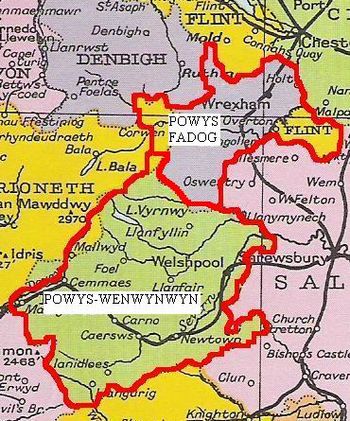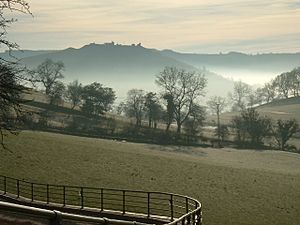Powys Fadog facts for kids
Powys Fadog (meaning Madog's Powys) was the northern part of an old Welsh kingdom called Powys. It was also known as Lower Powys in English. This area was a powerful Welsh principality during the Middle Ages.
Quick facts for kids
Principality of Powys Fadog
Tywysogaeth Powys Fadog
|
|||||||||
|---|---|---|---|---|---|---|---|---|---|
| 1160–1277 | |||||||||

Powys as divided in 1190.
|
|||||||||
| Capital | Dinas Brân and Glyndyfrdwy | ||||||||
| Common languages | Welsh | ||||||||
| Government | Monarchy | ||||||||
|
• 1160–1191
|
Gruffydd Maelor I | ||||||||
|
• 1191–1236
|
Madog ap Gruffydd Maelor | ||||||||
|
• 1236–1269
|
Gruffydd II | ||||||||
| Historical era | Middle Ages | ||||||||
|
• Established
|
1160 | ||||||||
|
• Conquered and dismantled by England
|
1277 | ||||||||
|
|||||||||
| Today part of | Wales | ||||||||
|
Powys Fadog was often known in English as Lower Powys
|
|||||||||
Contents
The Story of Powys Fadog
Powys Fadog was formed after the death of a ruler named Madog ap Maredudd in 1160. His kingdom of Powys was split into two parts. According to old Welsh law, Madog's nephew, Owain Cyfeiliog, received the southern part. This became Powys Wenwynwyn. Madog's son, Gruffydd Maelor I, inherited the northern part, which became Powys Fadog.
Early Rulers and Their Lands
Gruffydd Maelor I received lands like Maelor and Iâl. He later added more areas, including Nanheudwy, Cynllaith, Glyndyfrdwy, and Mochnant Is Rhaeadr. This northern kingdom became known as Powys Fadog. It was likely named after Gruffydd's son, Madog ap Gruffudd, who became ruler in 1191. Madog ruled until 1236.
Changing Alliances
During his time as ruler, Madog first tried to stay neutral. He didn't pick sides between the powerful Welsh kingdom of Gwynedd and England. But by 1215, he decided to form an alliance with Llywelyn ab Iorwerth of Gwynedd. This meant they would work together.
However, this alliance changed under the next ruler, Gruffudd II. He ruled for 33 years, from 1236 to 1269. Gwynedd was becoming very strong and put pressure on Powys Fadog. Also, Gruffydd married the daughter of an English landowner. Because of these reasons, he looked for support from the English king. But England didn't help him. So, in 1258, he was forced to join forces with Llywelyn ap Gruffudd of Gwynedd again.
Gruffydd's power started to fade. In 1267, Llywelyn was recognized as the Prince of Wales through the Treaty of Montgomery. After this, Gruffydd focused on building his castle, Castell Dinas Brân.
The End of Powys Fadog
When Gruffydd died in 1269, his oldest son, Madog II, became the ruler. But he gave very little land to his younger brothers. This caused a rebellion, and England got involved. By 1276, Powys Fadog was in chaos, with brothers fighting each other. This small conflict became part of a larger war. The English king was trying to conquer the Welsh lands.
In early 1277, an English army marched into Powys Fadog. They were led by the Earl of Warwick. They also had help from Dafydd ap Gruffydd, who was Llywelyn ap Gruffudd's brother but had turned against him. Madog II was forced to give up. His kingdom was to be divided between him and his younger brother Llywelyn.
The main royal castle, Castell Dinas Brân, was considered the strongest Welsh castle. But neither Madog nor his brother would get it. The castle was ordered to be taken apart.
It seems Madog II stayed at Dinas Brân for a while after this agreement. An English force was sent to take the castle on May 10, 1277. But before they could surround it, the small group of soldiers inside burned the castle and left. Madog II had to escape to Gwynedd for safety. He was killed later that year while fighting alongside Llywelyn ap Gruffudd. The ruins of Dinas Brân castle can still be seen today.
Madog's surviving brothers, Llywelyn Fychan and Gruffudd Fychan I, accepted English rule. Their lands were divided between them. Madog II's two sons also received some land. However, in 1282, during Llywelyn ap Gruffudd's final fight against England, all the rulers of Powys Fadog once again turned against England. In this last conflict, Llywelyn ap Gruffudd, Llywelyn Fychan, and Madog II's two sons all died.
After the Conquest
In 1284, the Statute of Rhuddlan was put in place. This law officially ended all the old Welsh princely titles and territories. Gruffydd Fychan, who was Madog II's brother and the last heir to the throne of Powys Fadog, was pardoned. But he became a less important local noble. His direct descendant, Owain Glyndŵr, would later lead a famous Welsh rebellion in 1400.
The land of Powys Fadog was broken up into smaller lordships. These were then combined with other nearby lands and made into new counties. For example, parts of Powys Fadog became part of Denbighshire and Flintshire. This system stayed in place until 1974.

Princes of Powys Fadog
The rulers of Powys Fadog belonged to the House of Mathrafal. This family had previously ruled the larger Powys. Here are the main rulers:
- 1160–1191 Gruffydd Maelor, Lord of Maelor and Yale
- 1191–1236 Madog ap Gruffydd Maelor, Lord of Powys
- 1236–1269 Gruffydd II ap Madog, Lord of Dinas Brân
- 1269–1277 Madog II ap Gruffydd, Lord of Dinas Brân
Later Lords of Glyn Dyfrdwy
After the conquest, some descendants still held important local titles:
- 1277–1289 Gruffydd Fychan I, Lord of Yale and Edernion, which included Glyndyfrdwy
- 1289–1304 Madog Crypl, Lord of Glyndyfrdwy and Lord of Cynllaith Owain
- 1304–c.1343 Gruffydd of Rhuddalt, Lord of Glyndyfrdwy and Lord of Cynllaith Owain
- c.1343–1369 Gruffydd Fychan II, Lord of Glyndyfrdwy and Lord of Cynllaith Owain
- 1369–c.1416 Owain ap Gruffydd, Lord of Glyndyfrdwy and Lord of Cynllaith Owain
Owain ap Gruffydd led a revolt against England in 1400 and declared himself Prince of Wales. He is better known as Owain Glyndŵr. After his death, at least one of his sons survived him. One of his brothers, Tudur ap Gruffudd, was known as the Lord of Gwyddelwern.
- 1416–c.1421? Maredudd ab Owain Glyndŵr



